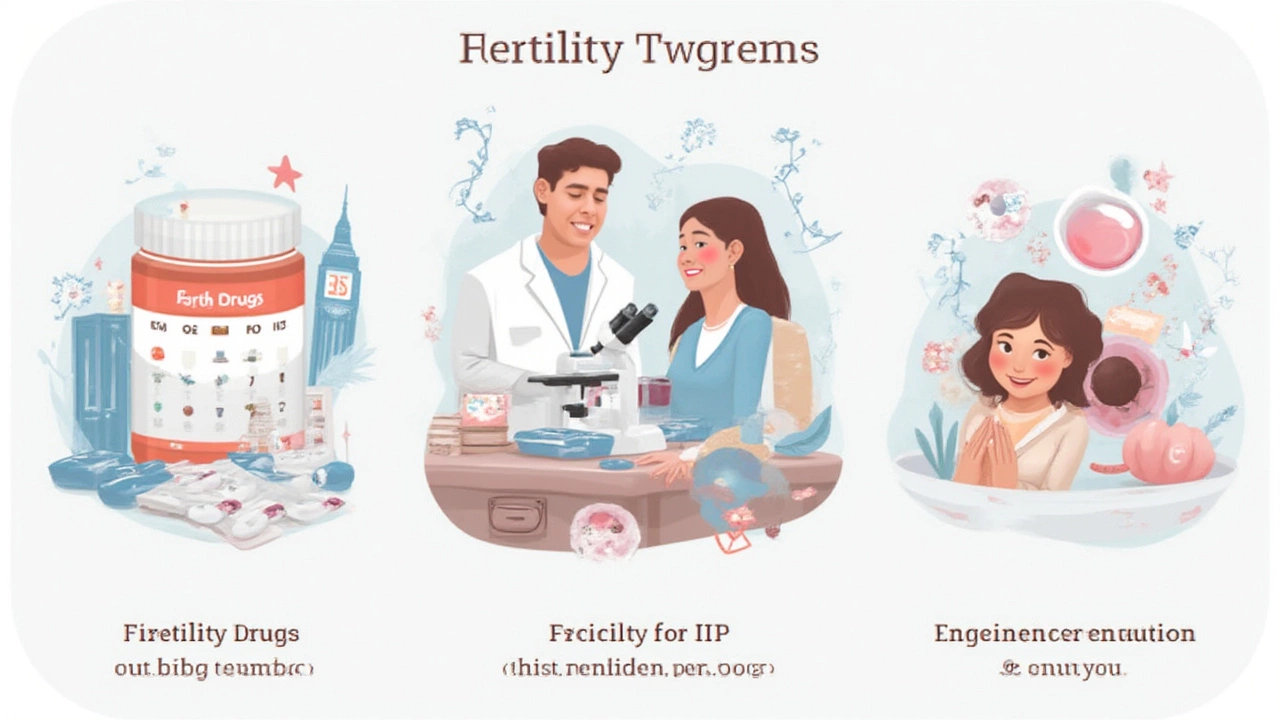Here’s a wild, and honestly uncomfortable, truth: about 1 in 6 couples run into fertility problems at some point. That moment you realize your pregnancy test keeps saying 'not this time' – it’s devastating. It’s not just movie drama. We don’t talk enough about the emotional tornado, the endless googling, the roller-coaster of hope and heartbreak. But here’s where things get interesting: modern medicine has come up with ways to tip the odds, and a lot of people walk through those clinic doors unsure what the options even mean. If your mind is spinning and you wish someone would just break it down, totally straight, no sugar-coating, this is for you.
Fertility Medications: The Classic First Step
You'd be surprised how many times the journey starts with something as simple-looking as a pill or an injection. Fertility drugs are often doctors' first pick because they’re relatively cheap and way less invasive than high-tech stuff. These meds serve two purposes: help you ovulate if your cycles are off (think PCOS or irregular periods), or supercharge ovulation so you release more eggs.
Clomiphene citrate—Clomid—is almost a celebrity among these meds. It’s a pill you usually take for five days early in your cycle. If that doesn’t work, doctors may turn to letrozole, originally a breast cancer drug but now a fan favorite for certain women. Then come injectable gonadotropins (FSH, LH), which are lab-made versions of your own reproductive hormones. These shots call the big guns, coaxing your ovaries to make multiple eggs instead of just one. This means—brace yourself—a way higher chance of twins (or more!) than Mother Nature usually plans for.
The most interesting bit? Around 80% of women who take Clomid will ovulate. Not all will conceive right away, but it’s a solid shot. Other stats worth knowing: about 33% of women will conceive within six cycles of using medications like Clomid, according to a 2023 report from the American Society for Reproductive Medicine.
What trips people up is thinking meds alone solve everything. They work best for women who don’t ovulate regularly. If the problem is blocked tubes or severe sperm issues, medications won’t fix it. And side effects? You might be dealing with mood swings, hot flashes, headaches, or feeling like you swallowed a beach ball from ovarian swelling—totally normal, though annoying as heck. And just to keep things extra real, your doctor should track you with blood tests and ultrasounds to dodge one of the biggest risks: ovarian hyperstimulation syndrome (OHSS). No one wants a trip to the ER for that.
Intrauterine Insemination (IUI): Giving Sperm a Shortcut
Next up: IUI, sometimes called artificial insemination. Think of IUI as helping sperm out by skipping the biggest hurdle—the long, unpredictable swim up to the uterus. Here, the doctor takes sperm (washed in the lab to pick out the best swimmers) and places them right in your uterus using a thin tube, timed perfectly with ovulation.
Who’s a good candidate? Couples with mild male factor infertility (like low sperm count), unexplained infertility, women with cervical mucus issues, or single women and same-sex couples using donor sperm. IUI is also popular when using fertility meds, to coax out more eggs and stack the odds even higher.
Here come the numbers: the average IUI success rate for women under 35 is 10% to 20% per cycle. That means if you do it a few times in a row, your chances add up (but don’t multiply—biology isn’t that generous). Most clinics suggest trying around three to six IUIs before considering something more high-tech. For women over 40, success rates drop closer to 5% per cycle—biology gets a little stingier with age.
IUI is quick—under 10 minutes—and feels like getting a Pap smear for most women. You’ll be back at work the same day. But here’s the catch: it’s not magic. If there’s any major problem with the fallopian tubes or the sperm can’t swim at all, IUI won’t work. And, as with meds, more eggs can mean more babies—yes, twins or triplets. Not always the fairytale, since multiples carry higher health risks for everyone involved.

In Vitro Fertilization (IVF): The Gold Standard
Now, the heavyweight of fertility treatments: IVF, or in vitro fertilization. Remember all those movies with doctors mixing things in glass tubes? That’s not entirely off. In IVF, ovary-stimulating drugs kickstart multiple eggs to grow at once. The doctor retrieves these eggs with a needle (ultrasound-guided, thankfully). Sperm (from a partner or donor) meets egg in a lab dish, and, if all goes right, embryos form. A healthy embryo is then transferred straight into the uterus. Any extras? You can freeze them for another shot later on.
The tech has come so far. People with blocked tubes, endometriosis, male infertility, advanced age, or just unexplained 'bad luck' may all be offered IVF. And it’s not just about 'making a baby in a lab.' Specialists can use techniques like ICSI—where a single sperm is injected into an egg—if sperm quality is the problem. Preimplantation genetic testing (PGT), another add-on, screens for genetic diseases or chromosomal problems before anything is transferred.
The success rates? Here’s where the numbers matter. According to the CDC’s 2024 fertility clinic report, about 45% of IVF cycles for women under 35 result in a live birth. For those 38-40, the rate drops to around 25%. For women over 42, it’s closer to 5%. That’s why fertility docs are always talking age, age, age. Fascinating, frustrating, but true—the younger the eggs, the better the chances.
IVF sounds futuristic, but it’s a slog. You’ll be giving yourself hormone shots, shuffling back and forth for ultrasounds, and timing everything to the hour. Usually, the egg retrieval involves light sedation, but you’re up and about pretty fast. The embryo transfer feels like a Pap test, no anesthesia needed. There’s a nerve-wracking two-week wait to see if it worked, and, for some, yet another round if it doesn’t.
| Age Group | IVF Success Rate (Live Birth per Cycle) |
|---|---|
| Under 35 | 45% |
| 35-37 | 37% |
| 38-40 | 25% |
| 41-42 | 11% |
| Over 42 | 5% |
One tip: ask your doctor about fresh vs. frozen embryo transfers. New research hints frozen can sometimes have better chances with fewer risks. Also, not all clinics are created equal, so look up the latest success rates for your clinic, not just national averages.
How to Choose the Right Fertility Treatment
So how do you decide what’s right for you? It honestly depends on your unique biology and history. If you’re young with ovulation issues, starting with medication is logical. For mild male fertility issues or if you just want to 'nudge' nature along, IUI fits. IVF is the go-to for blocked tubes, severe male infertility, anyone who’s already tried other options, or those using genetic screening.
Fertility treatments are not 'one size fits all.' Financials matter too. A cycle of IUI costs around $300-1,000, while IVF runs $10,000-20,000 per cycle—and often isn’t covered by insurance. Medications vary by brand and if you use brand or generic, but they’re typically the cheapest starting line.
Try this roadmap to figure out next steps:
- Know your numbers: Get baseline fertility testing—hormones, AMH, ultrasound, semen analysis.
- Consider your timeline: Age plays a massive part. If you’re over 35, you might not want to try low-tech stuff for too long before stepping up.
- Ask about add-ons: Things like ICSI, PGT, and frozen embryo transfers can make a difference when the situation calls for it.
- Budget for reality: Think about how many tries you could realistically afford, emotionally and financially, so you’re not blindsided later.
- Don’t go it alone: Find support—a partner, therapist, or a solid friend group. There are amazing online infertility communities, too.
And this may sound too simple, but: keep hope close, but expectations flexible. The science is better than ever, but it doesn’t promise a baby to everyone. Your journey is your own, and even with the best efforts, sometimes the outcome veers off course. Remember, you have options, and often, a stubborn mix of persistence, creativity, and plain luck gets couples through the storm. If you keep asking questions, pushing for good care, and refusing to let setbacks define you, you’re already winning in ways numbers never quite capture.
